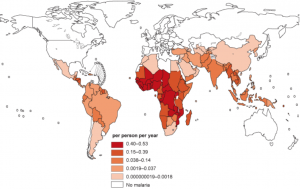QUESTION:
Where are the high risk areas of malaria?
ANSWER:
Malaria is found in many tropical and sub-tropical parts of the world, although a few areas, through concerted control and prevention efforts, have eliminated the disease locally. Examples of this are the USA, most of the Mediterranean and parts of Central America. The highest burden of the disease is in Africa, although many parts of Asia, particularly India and south-east Asia, also suffer from a large number of cases every year. The map shows the risk of malaria around the world.
